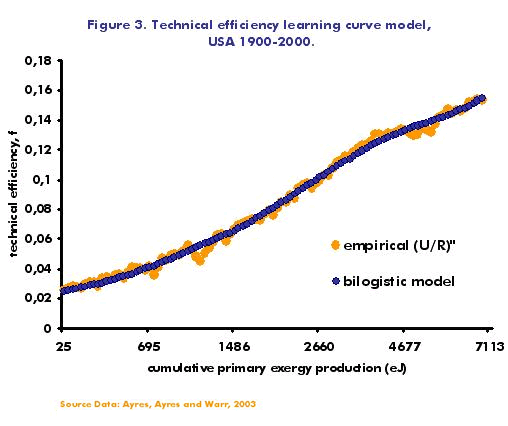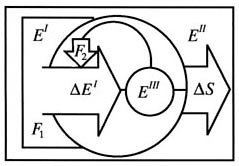 |
 |
||||||||||
The dynamics of technical efficiency progress - part 1, by Benjamin Warr and Robert Ayres
Human capital lies at the heart of the learning process. Individuals learn through direct production experience and indirect experience passed on to them through education. Experience generates a repository of knowledge which is the source for new innovations, which in turn drive the process of technological progress.
So what is technology and how does it relate to knowledge, moreover what relevance natural resources? In one of its guises, technology can be considered as "knowledge combined with the appropriate means to transform materials, carriers of available energy, or other types of information from less to more desirable forms". The most general definition of technological distance is then information content.
Remember: "Information is a basic aspect of all systems, the role of the observer is to define boundaries, and to this extent information content is a subjective concept. Once boundaries are defined, the information content of a subsystem is a measure if its distinguishability from the surrounding system".
Different types of information include - (links to come :)
|
|
|
|
|
|||||
| Thermodynamic
information determined by differences in physical state, for example temperature, colour, pressure, chemical potential (composition), of the subsystem relative to the background. |
Morphological
information determined by differences in shape, form and structure relative to "random" background. |
Symbolic
information |
Knowledge |
|||||
How can we measure information, accepting that information in its various guises contributes to technological progress? We do not envisage ever measuring the flows of symbolic information through the economy however interesting. However, the information content for thermo-dynamic systems is exactly proportional to the general thermodynamic potential, which is also referred to as 'useful work'. The concept of useful work is discussed in greater detail elsewhere. Flows of useful work are required to organise all other forms of information (morphological, symbolic, knowledge).
The ratio of useful work U, delivered to primary natural resource exergy (available work) supplied R, describes the aggregate technical efficiency f, of natural resource exergy conversion. The technical efficiency (f = U/R) is a fraction equal to the thermal efficiency of the conversion process of raw primary exergy (for example oil, gas, coal, metals) into useful work (for example electricity).
The technical efficiency of exergy conversion is a physically quantifiable index of the combined impacts of human innovations, capital and labour quality improvements on the 'quality' of the flows of 'useful work' also referred to as thermodynamic information.

We fit a bi-logistic learning curve to the aggregate technical efficiency of primary exergy conversion from the US for the period 1900-2000. The empirical data and the model are presented in figure 3 above. The model captured the steady transition throughout the century. The period of slow improvement in the late 1960s (~4677Ej) and subsequent improvements since the oil crises of the 70s and 80s are reasonably well reproduced.

We also fit technical efficiency learning curves to data for the US for each of the three major fossil fuels (coal, oil, gas - single logistic model). More detailed results are presented in a draft report. The learning curves for each fuel reflects the history of exergy services they were used to provide and historical technology progress. The individual fits are not as pleasing as that for the aggregate measure, nevertheless they are statistically 'optimal'.
We sought reasons why the models for individual fuels
poorly fit the empirically observed growth in technical efficiency. A
solution became apparent by considering the dynamics of the process of
technical efficiency change. A logistic model can be formulated as the
net result of combining two processes, birth and death. However, the fitted
model does not allow the technical efficiency to fall, as is the observed
case for gas in the early 1970s as consumers substituted gas for oil in
inefficient home space heating systems.
Read on in creative destruction part II in which a dynamic model of creative-destruction is presented
Ayres, R. U. (1994). "Toward a non-linear dynamics of technological progress." Journal of Economic Behavior and Organization 24: 35-69.
Warr, B. and R.U. Ayres (2003). "Exergy conversion technical efficiency learning curves, US 1900-2000". Draft Working Paper - available for download.
| home | ||||||





